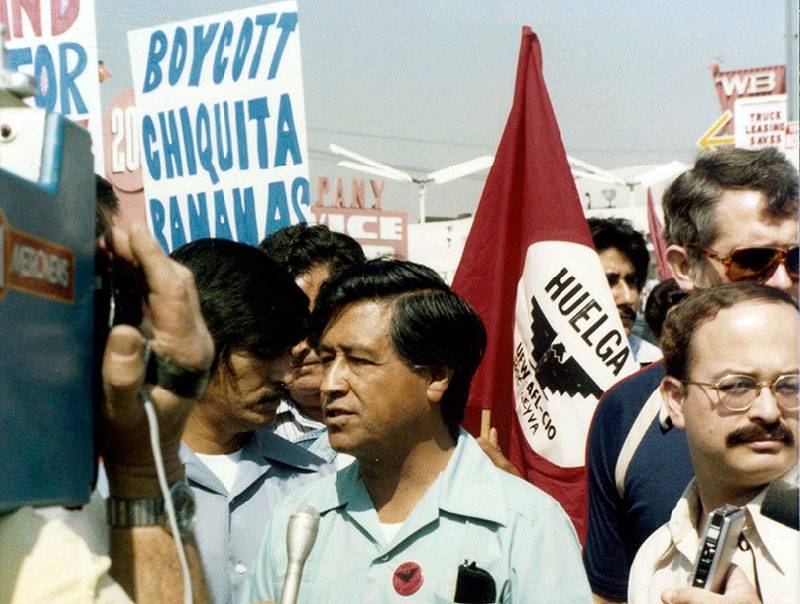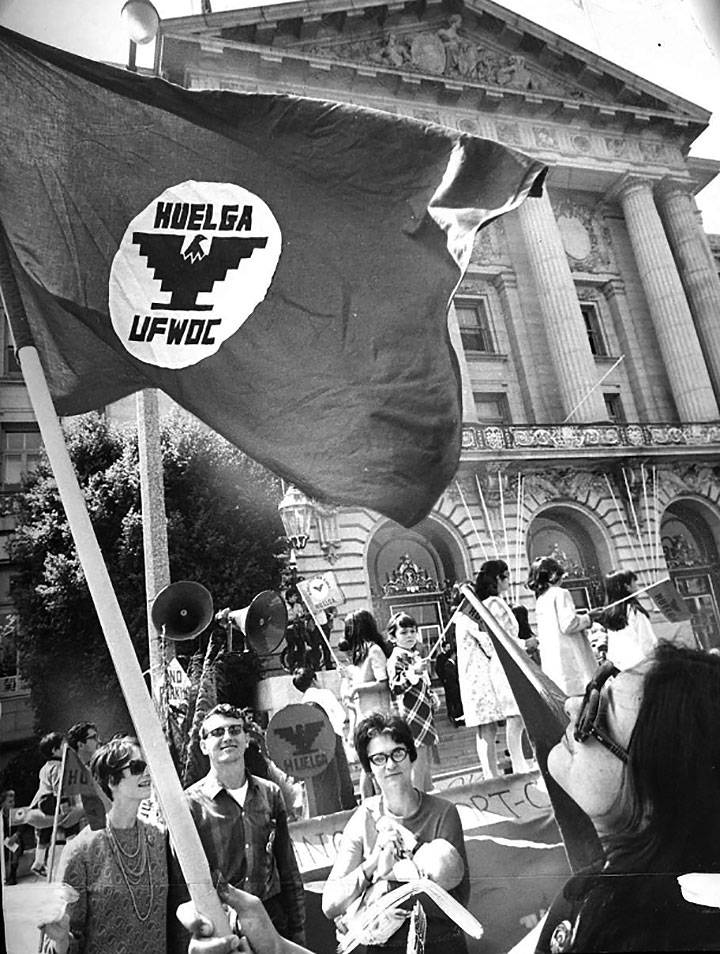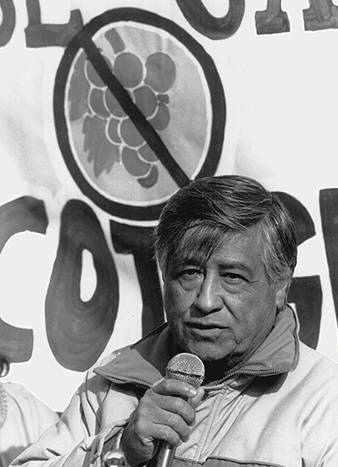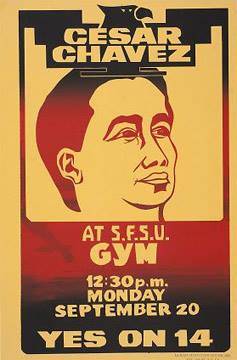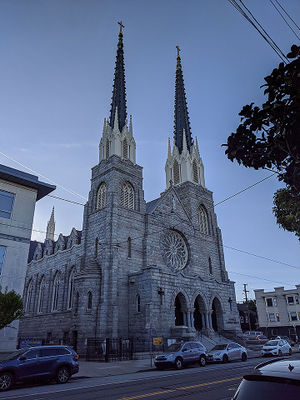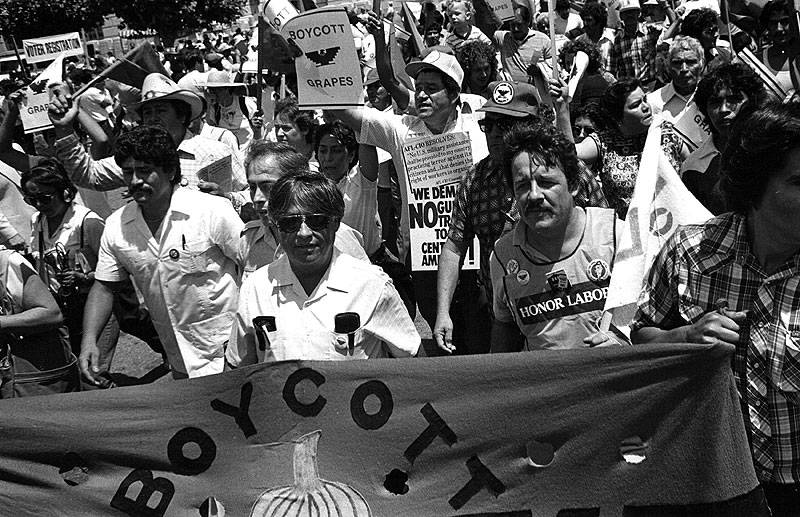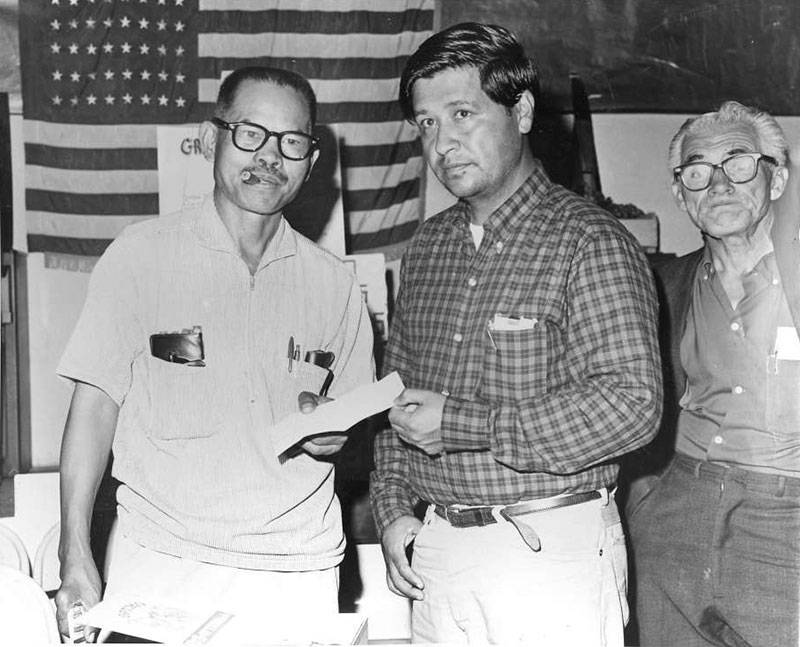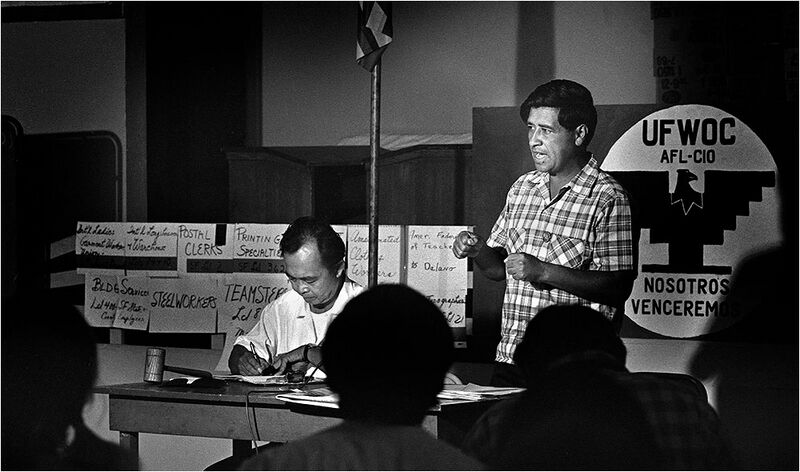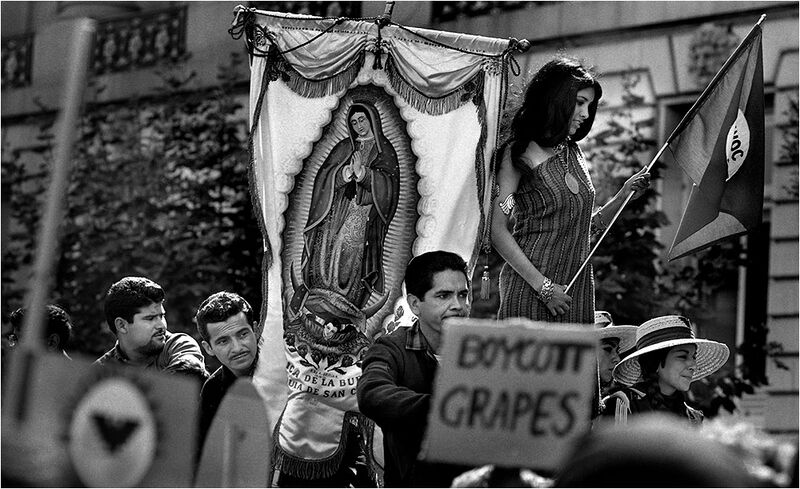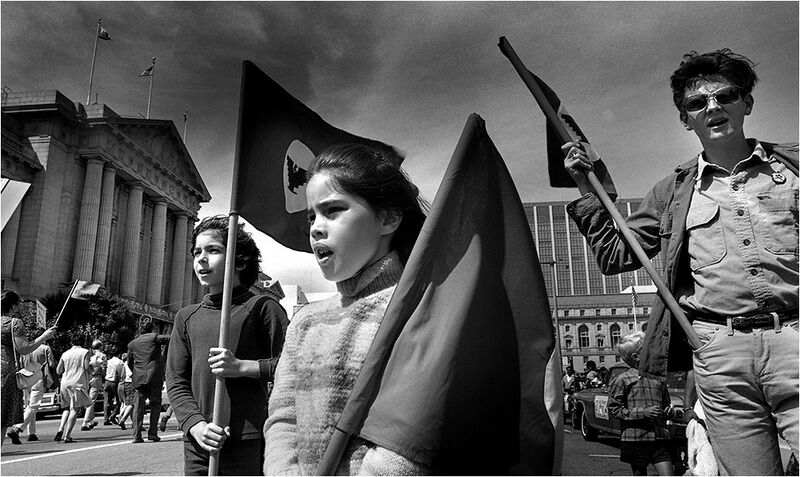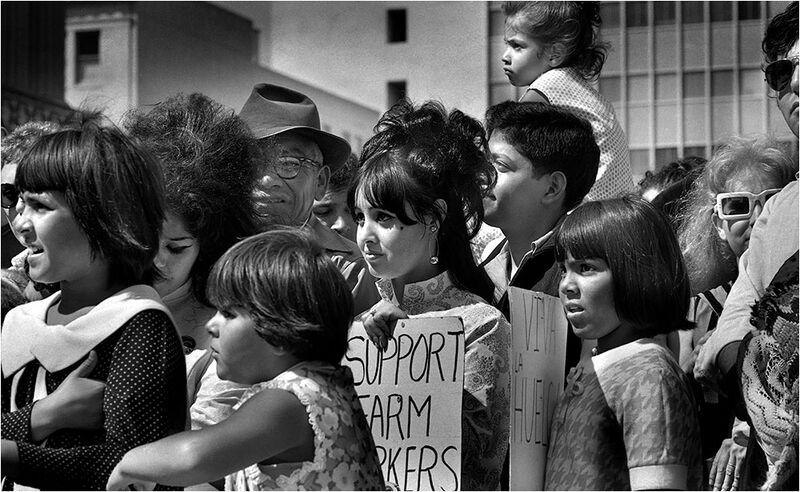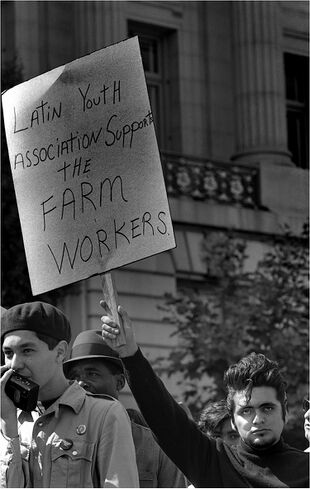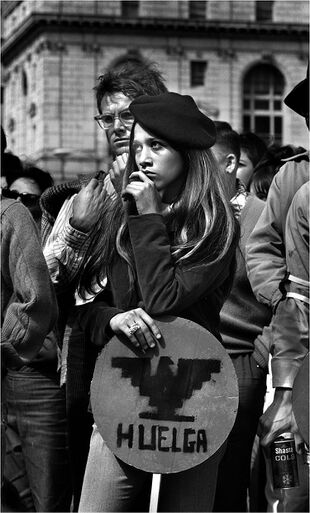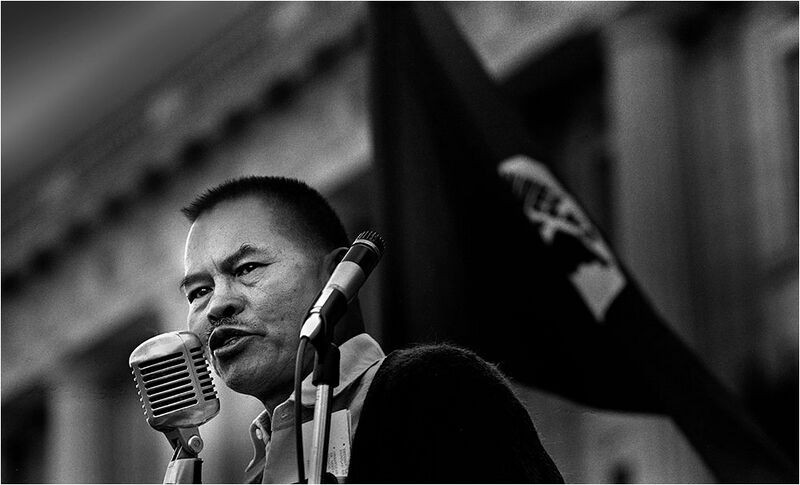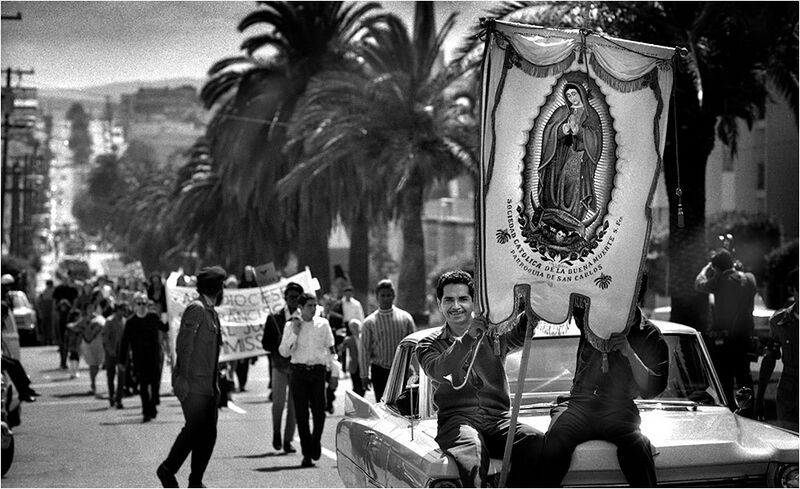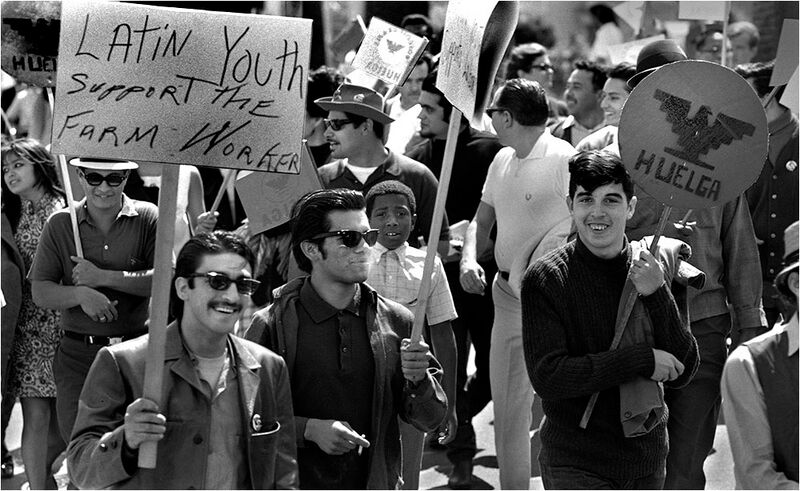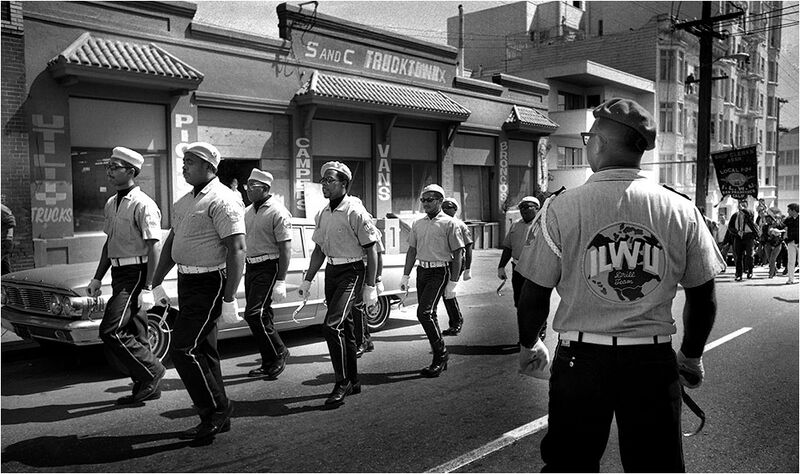CESAR CHAVEZ and San Francisco: Difference between revisions
(added photo and category) |
(added Ted Kurihara photos) |
||
| (4 intermediate revisions by the same user not shown) | |||
| Line 3: | Line 3: | ||
''by Jesse Drew'' | ''by Jesse Drew'' | ||
<iframe src="https://archive.org/embed/hidden-san-francisco-stop-e-23-ufw-v-ddt" width="640" height="480" frameborder="0" webkitallowfullscreen="true" mozallowfullscreen="true" allowfullscreen></iframe> | |||
'''Cesar Chavez addresses San Francisco grape boycott rally in the mid-1980s. ''' | <hr> | ||
[[Image:Foundsf-hsf-icon.gif|link=Harry Bridges]]<br> | |||
Next Stop #7: [[Harry Bridges|Harry Bridges Plaza]] | |||
<hr> | |||
[[Image:United-v farm-workers-delano-grape-strike 13.jpg]] | |||
'''Cesar Chavez at the 1965 grape pickers strike in Delano, California.''' | |||
''Photo: provenance unknown'' | |||
[[Image:UFW-rally-at-City-Hall-Sept-15-1968 Greg-Robinson-SFC.jpg]] | |||
'''UFW rally at City Hall, September 15, 1968.''' | |||
''Photo: Greg Robinson'' | |||
[[Image:labor1$cesar-chavez-photo.jpg|left]] [[Image:Cesar chavez poster 10013936 10152342167867154 679539362 n.jpg|right|290px]] | |||
'''Cesar Chavez addresses San Francisco grape boycott rally in the mid-1980s. ''' | |||
''Photo: Rick Gerharter'' | |||
[[Image:St-Pauls 20200422 184852.jpg|300px|right]] | |||
'''St. Paul's Church in Noe Valley, were the UFW had a collective of full-time urban organizers in the nunnery in the 1970s.''' | |||
''Photo: Chris Carlsson'' | |||
Though San Francisco may be a long ways off from the hot and dusty fields of Coachella and Delano, the City by the Bay has always had a close and congenial relationship with Cesar Chavez and the United Farmworkers Union. Cesar came to the City often, where he could rely upon a strong supportive community of Latinos, radicals, unionists, and other progressives. When the grape strike, and then the lettuce strike was in full swing, and he saw the violence perpetrated on the striking workers, he introduced what he called "the double whammy" of the strike and boycott weapons. To complement the strike actions in the fields, the UFW embarked on a major effort in the cities to enlist consumers in the fight, by refusing to buy scab grapes and lettuce. The UFW could count on San Francisco consumers to help. For many years UFW pickets could be found obstructing traffic at large retailers of scab produce, such as Safeway Stores and Lucky Stores. San Francisco produce terminal workers would often refuse to unload scab produce as well. In addition, the city's growing network of community co-ops would support the union by selling UFW-picked produce. In the 1970s, the Farmworkers had a collective household of full-time urban organizers in the nunnery located in [[St Paul's |St. Pauls church]] at 29th and Noe (coincidentally, the same church featured in the Whoopi Goldberg movie "Sister Act.") | Though San Francisco may be a long ways off from the hot and dusty fields of Coachella and Delano, the City by the Bay has always had a close and congenial relationship with Cesar Chavez and the United Farmworkers Union. Cesar came to the City often, where he could rely upon a strong supportive community of Latinos, radicals, unionists, and other progressives. When the grape strike, and then the lettuce strike was in full swing, and he saw the violence perpetrated on the striking workers, he introduced what he called "the double whammy" of the strike and boycott weapons. To complement the strike actions in the fields, the UFW embarked on a major effort in the cities to enlist consumers in the fight, by refusing to buy scab grapes and lettuce. The UFW could count on San Francisco consumers to help. For many years UFW pickets could be found obstructing traffic at large retailers of scab produce, such as Safeway Stores and Lucky Stores. San Francisco produce terminal workers would often refuse to unload scab produce as well. In addition, the city's growing network of community co-ops would support the union by selling UFW-picked produce. In the 1970s, the Farmworkers had a collective household of full-time urban organizers in the nunnery located in [[St Paul's |St. Pauls church]] at 29th and Noe (coincidentally, the same church featured in the Whoopi Goldberg movie "Sister Act.") | ||
| Line 15: | Line 46: | ||
''Photo: Keith Holmes'' | ''Photo: Keith Holmes'' | ||
[[Image:Itliong-and-Chavez.jpg]] | |||
'''Larry Itliong of the Agricultural Workers Organizing Committee and Cesar Chavez when they joined together to found the United Farm Workers Union.''' | |||
''Photo: provenance unknown'' | |||
[[Image:Ted-Kurihara UFW 366-D-27-CESAR-CHAVEZ-Grape-Strike-and-Boycott-Meeting-Delano,-CA-8-24-1968 0366-d-027-copy-1.jpg|800px]] | |||
'''Cesar Chavez conducts a grape boycott meeting in Delano, California, August 24, 1968.''' | |||
''Photo: © [https://tedkuriharaphotography.com/ Ted Kurihara]'' | |||
[[Image:Ted-Kurihara-UFW-Civic-Center-1968-Virgin-of-Guadalupe-0373-c-032-copy-1.jpg|800px]] | |||
'''UFW grape boycott rally at San Francisco Civic Center, 1968.''' | |||
''Photo: © [https://tedkuriharaphotography.com/ Ted Kurihara]'' | |||
[[Image:Ted-Kurihara UFW-at-City-Hall 0373-d-034-copy-1.jpg|800px]] | |||
[[Image:Ted-Kurihara-UFW-Civic-Center-August-1968 0373-c-026-copy-1.jpg|800px]] | |||
[[Image:Ted-Kurihara-Latin-Youth-with-hair 0373-c-025-copy-1.jpg|310px|left]] [[Image:Ted-Kurihara UFW Huelga August-1968 0373-a-006-copy-1.jpg|right|310px]] | |||
''Photos: © [https://tedkuriharaphotography.com/ Ted Kurihara]'' | |||
[[Image:Ted-Kurihara-Larry-Itliong-0373-h-008-copy-1.jpg|800px]] | |||
'''UFW leader Larry Itliong addresses the rally at City Hall.''' | |||
''Photo: © [https://tedkuriharaphotography.com/ Ted Kurihara]'' | |||
[[Image:Ted-Kurihara-Virgin-on-Dolores-St 0373-f-027-copy-1.jpg|800px]] | |||
'''UFW Boycott rally proceeds up Dolores Street, 1968.''' | |||
[[Image:Ted-Kurihara-Latin-Youth-Support-Farmworkers-on-Dolores-Street-1968 0373-e-020-copy-1.jpg|800px]] | |||
[[Image:Ted-Kurihara-ILWU-marching-team-Dolores-Street-1968 0373-e-028-copy-1.jpg|800px]] | |||
'''[[:Category:ILWU|ILWU]] Drill Team marches near Dolores and Market in support of the UFW Boycott, 1968.''' | |||
''Photos: © [https://tedkuriharaphotography.com/ Ted Kurihara]'' | |||
[[1937 Department Store Strike |Prev. Document]] [[Local 2 and the Alliance of Rank and File |Next Document]] | [[1937 Department Store Strike |Prev. Document]] [[Local 2 and the Alliance of Rank and File |Next Document]] | ||
[[category:Labor]] [[category:Famous characters]] [[category:1970s]] [[category:food]] [[category:Latino]] [[category:1980s]] | [[category:Labor]] [[category:Famous characters]] [[category:1960s]] [[category:1970s]] [[category:food]] [[category:Latino]] [[category:1980s]] | ||
Latest revision as of 21:16, 25 February 2024
Historical Essay
by Jesse Drew
<iframe src="https://archive.org/embed/hidden-san-francisco-stop-e-23-ufw-v-ddt" width="640" height="480" frameborder="0" webkitallowfullscreen="true" mozallowfullscreen="true" allowfullscreen></iframe>
![]()
Next Stop #7: Harry Bridges Plaza
Cesar Chavez at the 1965 grape pickers strike in Delano, California.
Photo: provenance unknown
UFW rally at City Hall, September 15, 1968.
Photo: Greg Robinson
Cesar Chavez addresses San Francisco grape boycott rally in the mid-1980s.
Photo: Rick Gerharter
St. Paul's Church in Noe Valley, were the UFW had a collective of full-time urban organizers in the nunnery in the 1970s.
Photo: Chris Carlsson
Though San Francisco may be a long ways off from the hot and dusty fields of Coachella and Delano, the City by the Bay has always had a close and congenial relationship with Cesar Chavez and the United Farmworkers Union. Cesar came to the City often, where he could rely upon a strong supportive community of Latinos, radicals, unionists, and other progressives. When the grape strike, and then the lettuce strike was in full swing, and he saw the violence perpetrated on the striking workers, he introduced what he called "the double whammy" of the strike and boycott weapons. To complement the strike actions in the fields, the UFW embarked on a major effort in the cities to enlist consumers in the fight, by refusing to buy scab grapes and lettuce. The UFW could count on San Francisco consumers to help. For many years UFW pickets could be found obstructing traffic at large retailers of scab produce, such as Safeway Stores and Lucky Stores. San Francisco produce terminal workers would often refuse to unload scab produce as well. In addition, the city's growing network of community co-ops would support the union by selling UFW-picked produce. In the 1970s, the Farmworkers had a collective household of full-time urban organizers in the nunnery located in St. Pauls church at 29th and Noe (coincidentally, the same church featured in the Whoopi Goldberg movie "Sister Act.")
Cesar Chavez leading a UFW march at the 1984 Democratic National Convention in San Francisco.
Photo: Keith Holmes
Larry Itliong of the Agricultural Workers Organizing Committee and Cesar Chavez when they joined together to found the United Farm Workers Union.
Photo: provenance unknown
Cesar Chavez conducts a grape boycott meeting in Delano, California, August 24, 1968.
Photo: © Ted Kurihara
UFW grape boycott rally at San Francisco Civic Center, 1968.
Photo: © Ted Kurihara
Photos: © Ted Kurihara
UFW leader Larry Itliong addresses the rally at City Hall.
Photo: © Ted Kurihara
UFW Boycott rally proceeds up Dolores Street, 1968.
ILWU Drill Team marches near Dolores and Market in support of the UFW Boycott, 1968.
Photos: © Ted Kurihara

